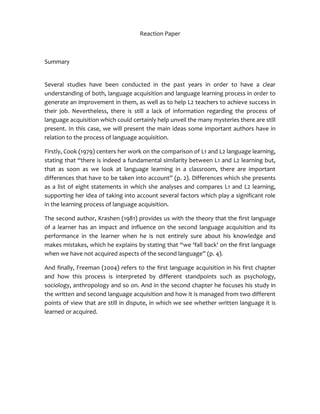
Reaction Paper II
- 1. Reaction Paper Summary Several studies have been conducted in the past years in order to have a clear understanding of both, language acquisition and language learning process in order to generate an improvement in them, as well as to help L2 teachers to achieve success in their job. Nevertheless, there is still a lack of information regarding the process of language acquisition which could certainly help unveil the many mysteries there are still present. In this case, we will present the main ideas some important authors have in relation to the process of language acquisition. Firstly, Cook (1979) centers her work on the comparison of L1 and L2 language learning, stating that “there is indeed a fundamental similarity between L1 and L2 learning but, that as soon as we look at language learning in a classroom, there are important differences that have to be taken into account” (p. 2). Differences which she presents as a list of eight statements in which she analyses and compares L1 and L2 learning, supporting her idea of taking into account several factors which play a significant role in the learning process of language acquisition. The second author, Krashen (1981) provides us with the theory that the first language of a learner has an impact and influence on the second language acquisition and its performance in the learner when he is not entirely sure about his knowledge and makes mistakes, which he explains by stating that “we ‘fall back' on the first language when we have not acquired aspects of the second language” (p. 4). And finally, Freeman (2004) refers to the first language acquisition in his first chapter and how this process is interpreted by different standpoints such as psychology, sociology, anthropology and so on. And in the second chapter he focuses his study in the written and second language acquisition and how it is managed from two different points of view that are still in dispute, in which we see whether written language it is learned or acquired.
- 2. Evaluation While reading the different texts, I have to admit I saw myself comparing them with the way I have learnt English not only in the University, but also in the previous years of my educational life. I have noticed many of the articles and researches I have read, made me question the method teachers use when teaching an L2. I found very interesting how Cook (1979) presented those eight statements and how we, as future teachers, should take them into account. It might sound obvious to some, but it makes a great difference to know exactly which are the things that makes L1 and L2 learning so distinct from each other. The one who caught my attention was the seventh, in which Cook (1979) states that “the child learns to adapt its language use to particular situations” (p.19) for I believe sometimes we tend to forget learners know how to manage in some situations with particular people. According to Cook (1979), children older than three years old tend to adapt their language by doing both omission and inclusion of syntax and vocabulary, in order to be understood by younger children (p. 20) which is why it is important to remember that language is flexible and by this I mean every learner has its own way of developing the language he or she has acquired, and knows how to use it. Another aspect which caught my attention and actually surprised me was the fact that correcting errors is not a recommendable attitude towards the learner and that according to Freeman (2004), we as future EFL teachers “should encourage children to explore their understandings and use language for making meaning rather than asking students to respond to their specific questions with formulaic answers” (p. 9). It is an important and strong statement because experience is vital in the process of learning not only a language but anything in life, which is why it is so important to let learners make mistakes and not to focus on them, but on the good things they have achieved which will help them develop a better understanding and usage of the language acquired. As Freeman (2004) noted “all students make errors. However, if their intent is to express their ideas, they will modify their language to make it more understandable to their listeners or readers” (p. 34). As a conclusion I have to admit I learned much more than I expected from these texts and some of them changed my way of thinking about the language acquisition process and hopefully will give me a different perspective when I become an EFL teacher. Camila Cuevas A.
- 3. References Cook, V. J., Long, J., & McDonough, S. (1979). First and second language learning. In G.E. Perren (ed), The Mother Tongue and Other Languages in Education: CILTR. Freeman, D. & Freeman, Y. (2004). Essential Linguistics: What You Need to Know to Teach Reading, ESL, Spelling, Phonics, and Grammar. Portsmouth, NH: Heinemann. Krashen, S. (1981). Second Language Acquisition and Second Language Learning. University of Southern California.
